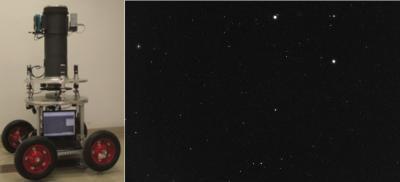As a kind of ground-based optical astrometric instrument, zenith telescope observes stars near zenith, which substantially reduces the influence of normal atmospheric refraction. Its high-precision observations can be used to calculate astronomical latitude and longitude, which are mainly applied in mobile measurement for deflection of the vertical, long-term measurement for the variations of the vertical, and related researches of astronomical seismology. Utilizing CCD camera, high-precision tiltmeter and other new technologies and devices, Chinese researchers have successfully developed a new type of Digital Zenith Telescope prototype, which will play a significant role in the interdisciplinary researches between astronomy and geoscience.
This paper, entitled "Digital zenith telescope prototype of China", has been published in Chinese Science Bulletin, 2014, Vol.59 (17) issue. In recent years, funded and committed by Shandong University of Science and Technology, Professor Hongqi Wang and his colleagues of National Astronomical Observatories, Chinese Academy of Sciences (NAOC) successfully developed the first CCD zenith telescope prototype (DZT-1) without mercurial plane of China and excellent results were obtained from the experimental observations.
Photographic zenith tube (PZT), astrolabe, transit instruments, etc. are called classical astrometric instruments. Because PZT observes stars near zenith, so PZT is the most precise classical astrometric instrument for earth rotation parameters (ERP) measurement in mid-20th century. Besides, since the observations of classical instruments are based on the plumb line decided by a mercury plane, they can get information about the variations of the local plumb line.
Measurements of the variations of the local plumb line are significant for interdisciplinary researches between astronomy and geoscience. The deflection of the vertical which denotes the inclination between geoid and reference ellipsoidal surface can be obtained by combining astrometric instruments and GPS. Especially, Chinese scholars found the phenomenon that short-term anomalous fluctuation appeared in the observations of classical astrometric instruments before major earthquake occurred around. It is considered that the observation data may be influenced by anomalous plumb line variations due to the motion of underground mass before earthquakes. Therefore, such data is valuable for the researches of earthquake prediction.

This shows the DZT-1 prototype and observation image.
(Photo Credit: ©Science China Press)
In the 1980s to 1990s, as a replacement for classical astrometric telescopes, new technical instruments with higher accuracy, such as Very Long Baseline Interferometry (VLBI), were used for ERP measurement because of their higher accuracy. However, the observations of the new technical instruments are incapable of measuring plum line variations.
Referring the overall optical structure of PZT, Chinese scholars utilized CCD camera as imaging terminal, and high-accuracy tiltmeter to replace mercurial plane, which improves the efficiency of DZT greatly. Dozens or even hundreds of stars can be processed concurrently in a single observation image. This subverts some special restrictions on classical astrometric methods, and makes DZT to be a high-precision, mobile and convenient astrometric instrument not only for station observations but also for field mobile geodetic survey. Figure1 shows the DZT-1 prototype and its observation image.
Since a CCD camera is adopted as the observation terminal, data processing of DZT, mainly consists of star image extraction, digital image centering, apparent star position calculation, automatic star identification, zenith position calculation, and inclination correction. According to the processing results of the data obtained in test observation, DZT has a single-observation accuracy up to 0.15-0.3″ and a whole-night observation accuracy up to 0.07-0.08″, which are equal to or better than the observation accuracy of classical astrometric instruments.
Unattended observation can be realized for DZT by remote control. Because of the miniaturization and removability, DZT is convenient for mobile measurement for deflection of the vertical, measurement for long-term variations of the vertical and related researches of astronomical seismology. Moreover, the project team has already considered the development of new DZT with better performance and studied the key techniques for new instrument to make DZT play a more significant role in the astronomy and geoscience fields.
Source: Science China Press